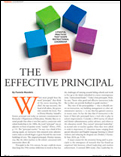The Principal Story Learning Guide
To advance the professional learning of aspiring and current school leaders

Unit 5: Managing people, data, and processes
Purpose: Unit 5 provides participants with an opportunity to identify principal behaviors necessary to address instructional deficiencies, use multiple sources of data, and create support systems and structures. Follow these links to move through the sections of this unit. Approximate Time: 4-5 hours.
Facilitators: Adult learning professionals may use this web-based learning tool in principal preparation courses or in workplace study sessions. Facilitators may encourage participants to take advantage of the writable PDFs to record and save their responses. For onsite study groups or classes, the facilitator may choose to print relevant worksheets and provide them to participants. Depending on class structure and learning goals, facilitators will use these tools to provide group and individual learning experiences within the following structure:
| Consider ideas and connect with others | |
| Watch the film clip | |
| Read the excerpt | |
| Complete the activities |
Consider ideas and connect with others
Think about the role of a school principal to manage people, data, and process. Independently, respond to questions on the worksheet and exchange responses with a partner. Connect with others, if applicable, to discuss common themes.
- What does it mean for principals to manage people, data, and processes?
- What examples of each action (managing people, data, and process) can you share from your own experience?
Watch the film clip
View a clip on managing people, data, and processes to see research in practice. Use the Big ideas chart to guide independent note-taking while viewing.
Clipboards in hand, area administrators conduct a walk-through of classrooms at Nash Elementary. They tell principal Tresa Dunbar they are looking for ways to improve instruction and benefit children. At Harvard Park, teachers incorporate data in a grade-level problem-solving session about low reading, math, and writing scores. [4 minutes, 42 seconds]
Read the excerpt
Excerpt from:
The School Principal as Leader: Guiding Schools to Better Teaching and Learning (The Wallace Foundation, 2013), 14-15.
Download excerpt in PDF format.
“In the great scheme of things,” noted one research report, “…schools may be relatively small organizations. But their leadership challenges are far from small, or simple.”1 To get the job done, effective leaders need to make good use of the resources at hand. In other words, they have to be good managers.
Effective leaders studied by University of Washington researchers nurtured and supported their staff members, while facing the reality that sometimes teachers don’t work out. They hired carefully, but — adhering to union and district personnel policies — they also engaged in “aggressively weeding out individuals who did not show the capacity to grow.”2
When it comes to data, effective principals try to draw the most from statistics and evidence, having “learned to ask useful questions” of the information, to display it in ways that tell “compelling stories” and to use it to promote “collaborative inquiry among teachers.”3 They view data as a means not only to pinpoint problems, but to understand their nature and causes.4
Principals also need to approach their work in a way that will get the job done. Research behind VAL-ED (the Vanderbilt Assessment of Leadership in Education), a tool to assess principal performance developed by researchers at Vanderbilt University, suggests that there are six key steps — or “processes” — that the effective principal takes when carrying out his or her most important leadership responsibilities: planning, implementing, supporting, advocating, communicating and monitoring.5 The school leader pressing for high academic standards would, for example, map out rigorous targets for improvements in learning (planning), get the faculty on board to do what’s necessary to meet those targets (implementing), encourage students and teachers in meeting the goals (supporting), challenge low expectations and low district funding for students with special needs (advocating), make sure families are aware of the learning goals (communicating), and keep on top of test results (monitoring).6
Complete the activities
Working in small groups or at their own pace, learners observe, discuss, engage, and reflect on the ideas and information presented in the film clips and related materials. Follow these links to tools that include writable PDF files to support this work.
| Activity 1: Discover personal assumptions | |
| Activity 2: Review research | |
| Activity 3: Link research with practice | |
| Activity 4: Take action | |
| Activity 5: Reflect |
Footnotes
1. Bradley Portin, Paul Schneider, Michael DeArmond and Lauren Gundlach. Making Sense of Leading Schools: A Study of the School Principalship, University of Washington, 2003, 14.
2. Bradley S. Portin, Michael S. Knapp, Scott Dareff, Sue Feldman, Felice A. Russell, Catherine Samuelson and Theresa Ling Yeh, Leadership for Learning Improvement in Urban Schools, University of Washington, 2009, 52.
3. Portin, Knapp et al., v.
4. Karen Seashore Louis, Kenneth Leithwood, Kyla L. Wahlstrom and Stephen E. Anderson, Learning From Leadership: Investigating the Links to Improved Student Learning: Final Report of Research Findings, University of Minnesota and University of Toronto, 2010, 195.
5. Andrew C. Porter, Joseph Murphy, et al. Vanderbilt Assessment of Leadership in Education, 16-19.
6. Porter, Murphy, et al., 141-142.
About
The Principal Story Learning Guide
Required Text
The Wallace Foundation. (2013). The school principal as leader: Guiding schools to better teaching and learning. New York: Author.
Optional Texts
Mendels, P. (2012, February). The effective principal. JSD, 33(1), 54-58.
Seashore-Louis, K., Leithwood, K., Wahlstrom, K., & Anderson, S.E. (2010). Learning from Leadership: Investigating the Links to Improved Student Learning. New York: The Wallace Foundation.
THE PRINCIPAL STORY
Offered in
collaboration with:





